Day 55: Waste Management
Dear Student,
On a truly self-sufficient homestead, very little is actually waste… Most of what urbanized folks call waste is an unused resource that you can put to work.
Let’s go through the categories of waste and see what we can do with them…
1) Food scraps and kitchen wastes: Feed them to your animals. What the animals won’t eat, feed to your worm farm or to your soldier fly digester. Once that is done use the residues as fertilizer or compost.
2) Organic farm wastes: Again, feed them to your chickens or pigs, or let your worms or soldier flies convert them into valuable inputs. High-carbon wastes like wood and twigs can be chipped and used as mulch or to lay around young trees to protect them from larger animals stepping on them.
3) Paper: All non-glossy paper can be used in your lasagna gardens as weed suppressants and for moisture retention. Use glossy paper by crumpling it up and using them to start fires in your stove or rocket mass heater.
4) Cardboard boxes: Similar to paper, if non-glossy use it in lasagna gardens or shred it and use it for making compost.
5) Plastics: Bottles can be reused by washing and decanting your homebrew beer or syrups into. Packaging can be used for insulation in animal housing and to plug gaps in walls. Hard plastic or Styrofoam can be ground and mixed into concrete for insulation or sent for recycling.
6) Cans and tins: Compact these and when you have a full load you can bring them to a nearby recycling center, where you are often paid a small amount for bringing them.
7) Glass bottles: Keep and reuse for holding wine or spirits you made yourself. Alternatively embed them in adobe or rammed earth construction to provide light into the interior of your home like a lightbox.
8) Reclaimed building materials: If you have to tear down an old structure on your property, salvage as much as you can for use in future animal housing needs.
9) Human wastes: This is where things get more complicated…
There are three forms of wastes that we generally have to deal with:
- Grey water: Wastewater from sinks and showers can be directed directly out into your garden to water and fertilize your plants.
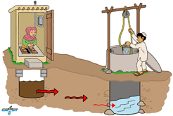
- Urine: This sterile, nutrient-rich waste product can be directed via pipe or bucket into your garden or compost heap.
- Black water: This is water that is contaminated by feces or just feces itself. This has to be broken down to prevent pathogens from spreading into your garden or into the groundwater. (If your water table is high, you might have to take additional measures to prevent contamination.)
Dry Toilets
Often called composting toilets, these use little or no water.
Regular flush toilets are one of the largest users of water in any household, and if you are in an area where water is scarce or you don’t want the expense of putting in a septic system and a leech field, dry toilets are a low-budget option.
The image of a smelly, fly-infested hole in the ground is incorrectly attributed to these kinds of toilets… dry toilets are a more sophisticated form of a pit toilet.
The volatile smell and disease-causing nutrients in excrement can be quickly stabilized and absorbed by fine, high-carbon materials that lock up the nutrients. It shouldn’t smell, and you recapture the nutrients for use on your farm after composting.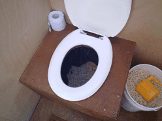
Composting toilets have two toilet seats and two chambers underneath to allow you to seal one off when full to compost and use the other.
These toilets can be built in homes with access from outside to remove the compost when ready or built as an outdoor toilet.
Dry Toilet Construction
Dry toilets can be made from many materials, including brick, concrete, adobe, or wood.
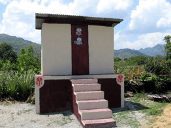 A concrete base for the collection chambers is best, but they can be built directly onto exposed soil if your water table is low and you put a foot of sawdust in first.
A concrete base for the collection chambers is best, but they can be built directly onto exposed soil if your water table is low and you put a foot of sawdust in first.
Build walls on all sides of the composting chambers and put a top to the chamber. Allow openings at the back wall of the chambers for a door to clean out each chamber after its contents have been properly composted.
Allow two holes through the top slab for your toilets to sit on. On the top slab you sit your toilets, which don’t have U-traps.
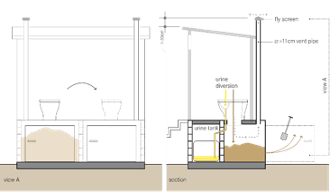 An air duct must go from each chamber to vent the gases at roof height to prevent smells.
An air duct must go from each chamber to vent the gases at roof height to prevent smells.
A bucket of sawdust sits beside the toilet and when you finish using it, you throw a scoop or two of sawdust down the hole to bind up the volatiles in the excrement below.
It is best to separate out urine from these toilets if you can, which can be done by installing a third toilet seat. This seat can be plumbed to run directly out into your garden to fertilize trees.
- Build the toilet up at least 4 feet from the bottom of the pit to allow enough space to fall and collect without backing up.
- Agitate the pile underneath your toilet with a long pole through the opening every couple of months to prevent piling up.
- Use as little toilet paper as you can.
- When you chamber is full, seal off the toilet with plastic over the seat and leave for a year.
- Use the other toilet seat until it fills up.
- After a year, come back and shovel out the rich clean humus out of the chamber through the back hatch and use in your garden.
- It won’t smell if composted correctly.
High-tech dry toilets are available these days that use electricity or gas to incinerate the wastes that go into them, producing a sterile output at a fast pace. These toilets require large amounts of power to run, though, and destroy many of the nutrients that you could recapture by slow composting.
Septic Systems
Modern septic systems consist of a septic tank for collecting and digesting wastes and a leech field to drain the water and nutrients out of the tank back into the ground.
The tanks are about 750 gallons in size for a normal house and up to 1,500 gallons for a large household. If you direct greywater and even urine water directly into your garden, you can get by with a much smaller unit.
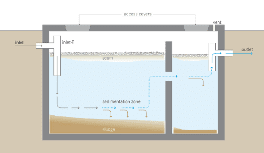 Tanks can be fiberglass, plastic, concrete, brick, or steel and they usually have two chambers. The first is to settle all solids and to begin the anaerobic digestion process. The second chamber allows finer particles through for final digestion before releasing out to the leech field.
Tanks can be fiberglass, plastic, concrete, brick, or steel and they usually have two chambers. The first is to settle all solids and to begin the anaerobic digestion process. The second chamber allows finer particles through for final digestion before releasing out to the leech field.
An overloaded septic system can allow undigested particles into your leech field and this can both cause clogging of your system and pollution of groundwater.
Most systems will require some maintenance in their lifetime (pumping out) unless well looked after.
Septic tank health:
- Avoid using heavy chemicals when cleaning your toilet, use natural cleansers.
- When first built, put a store-bought bacteria pack, a bag of compost, or a dead animal into your tank to kickstart the bacterial process.
- Consider converting your tank from septic to aerobic digester by installing a small solar air pump to pump air under the scum layer and seed the tank with beneficial aerobic bacteria you can buy from hardware stores (a disc like a hockey puck that floats in your tank). When installed correctly, these simple systems can break down material in the tanks much quicker than a normal septics and can prevent blockages. (If you go the aerobic route, you can only use natural cleaners in your toilet, no chemicals at all.)
Leech Field
The second part of conventional septic systems is the leech field.
This is where the digested matter from the second chamber of the system seeps out into the soil through a series of perforated pipes over a large area.
The water entering the leech field can still harbor pathogens; you are relying on the billions of bacteria in the soil to finish the decomposition process.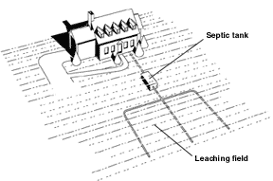
If your soil is compacted or has too much clay, dirty water can rise to the surface or drain into the water table without being cleaned properly, which is a serious issue.
Do a percolation test by digging a hole and filling it with water; see how long it takes to drain. If it doesn’t drain in a reasonable amount of time or if the water table is so high that you can’t bury the leech field, try Mother Nature’s best solution…
Reed Beds
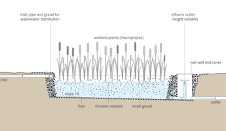 A reed bed is a ground-level, gravel leech bed in which you plant fast-growing reeds or bull rushes. These beds quickly grow large amounts of mulch for your garden, while quickly sanitizing the liquid outputs of your septic system.
A reed bed is a ground-level, gravel leech bed in which you plant fast-growing reeds or bull rushes. These beds quickly grow large amounts of mulch for your garden, while quickly sanitizing the liquid outputs of your septic system.
These systems have been used for thousands of years and are once again seen as the most sensible way of dealing with small- and large-scale effluent sanitation projects.
